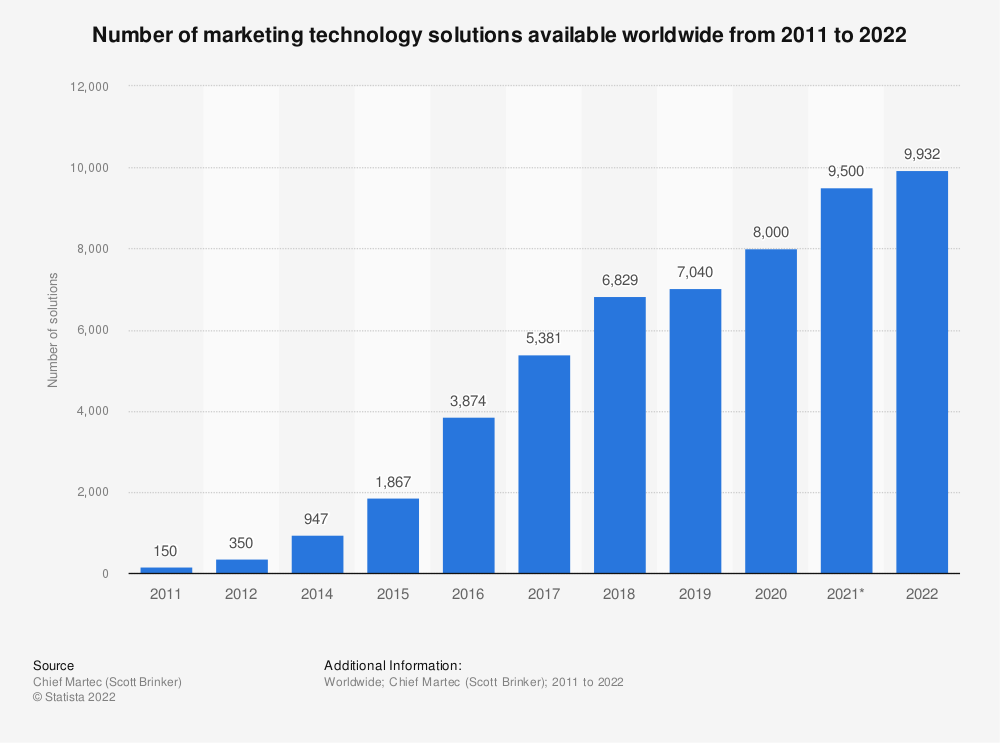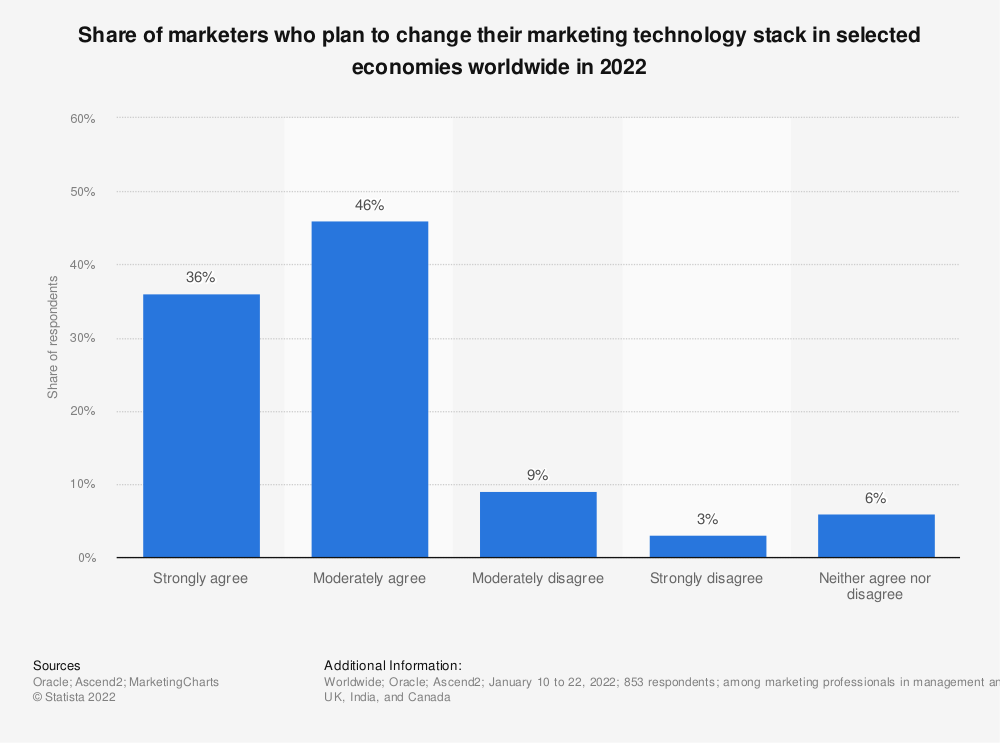What role does your martech stack play in improving customer retention?
It’s official: customers are running the show.
Today’s economic climate has made customer loyalty a vital ingredient for marketing success. But, with budgets cut and customers more concerned about value for money than ever before, customer loyalty is getting harder to achieve.

Customers are happy to shop around and track down the best brand that suits their needs at any given time. They’re less rooted in the recognized and more willing to try new brands. This works in your favor for customer acquisition but makes retention that much harder.
What is customer retention?
Customer retention refers to your business’s ability to retain customers over time. It’s generally a percentage metric measuring how may customers are retained by the end of a set time period.
Switched-on customers are engaging with a broad range of brands. In fact, today’s customer is 40% more likely to try new or different brands than five years ago. Only 29% prefer to stay with brands they’ve tried before.
How to calculate customer retention rates
There is a simple formula you can use to calculate your customer retention rate:
CRR = ((A-B/C) x 100
CRR: Customer retention rate
A: The number of customers you have at the end of a set time period
B: The number of newly acquired customers during the set time period
C: The number of customers you have at the start of a set time period
E.g. ((2000-543)/1500) x100 = 97% CRR
That’s not to say that all the hard work that goes into your brand marketing is irrelevant. Customers expect brands to have presence and purpose, but that alone is not enough to retain customers and drive repeat purchases.
Today’s consumer is 40% more likely to try new or different brands than five years ago. What does this mean for customer loyalty?
Customers want value and accessibility
Dotdigital’s latest report into customer behaviors found that the top three motivators for signing up to newsletters are:
- To claim the signup discount/offer (35%)
- To hear about future promos (33%)
- To become part of their loyalty programs (30%)
Pair this with the fact that affordability and value for money are key considerations during the purchasing process, and it’s clear that customers are looking for the best deal they can get.
We also discovered that once a customer has subscribed to your email marketing, 31% interact with your social media channels once a day. Most customers (57%) interact on social channels at least once a week. And, in addition to this, 38% claim to visit a brands website at least once a week too.
This re-emphasizes the importance of creating connected and consistent experiences across all your channels.
One stack for all your marketing goals
It has been predicted that by the end of 2022 there will be nearly 10,000 marketing technology solutions available for marketers.

With the vast number of technologies on offer, it’s not surprising to discover that 80% of marketers plan to update their marketing stack this year.

If you’re amongst the vast majority of marketers looking for a change, it’s important you build a martech stack that can do it all. But, if the goal is improved retention, what do you need to be looking for?
Marketing automation
Marketing automation is your hub, the central point of your marketing stack that brings everything together and keeps the wheel turning.
As well as simplifying workflows and improving the efficiency of your team, an intelligent marketing automation platform will offer you data-driven insights and advanced reporting options. This will empower you to continuously optimize and develop your marketing strategy.
Customer data
Today, the bulk of customer interactions with your brand come online. When building your ultimate marketing stack, you need to be constantly thinking about your customer data. You need a CRM or ecommerce platform that plays nicely with others.
What is CRM?
CRM stands for Customer Relationship Management. It’s software that manages interactions with customers and potential customers and helps businesses build strong customer relationships. Effective use of a CRM will enable you to streamline processes so you can increase sales, improve customer service, and increase profitability.
Your CRM and your marketing automation should be a match made in heaven. Interactions recorded in your CRM will trigger and inform your marketing automation strategy.
Single customer view
If you’re looking to improve retention, understanding your customers is essential. The only way you can get a truly comprehensive view of your customers – their drives, motivations, and needs – is with a single customer view.
Single customer view (SCV) pulls in data from all your platforms to create a 360-degree profile of your customer. This gives you insight into your customers like never before. Crafting personalized and relevant customer journeys is a big winner when it comes to customer retention, and with SCV this is made easy.
Loyalty programs
Loyalty programs are now one of the three top motivators driving new email subscriptions. Intelligent and engaging loyalty programs can be created using a loyalty management system.
A loyalty management system helps you build stronger relationships with your audience. Depending on your business and your goals, there are many different types of loyalty programs you can add to your marketing strategy. Tiered programs allow customers to gain access to additional benefits as they advance through the ranks. Points-based programs reward customers for the money they spend.
In order for a loyalty program to work, it needs to be stacked with your automation program and your CRM. This enables effective tracking. When a customer spends money or interacts with your brand a fully integrated stack will ensure it’s tracked in your loyalty program.
Reviews, social proof, and UGC
Social proof is a vital part of new customer acquisition – people trust the unbiased reviews of their peers more than the word of the brand – but it’s also a great retention tool.
Customers’ drive towards more personalized and relevant content stems from their desire to be seen as more than just a contact in the address book. Collecting and displaying customer reviews and UGC (user-generated content) demonstrates that you’re a brand that listens to its customers and has nothing to hide. Authenticity is an important factor in creating loyal customers and nothing is more authentic than a review.
When building your stack, you need a reviews platform that can plug in and play with all your marketing channels. Automated emails and SMS should be triggered as part of the post-purchase journey to collect feedback. You need a review platform that can be pulled into your emails, landing pages, and websites.
Every brand looking to improve customer retention should have an integrated reviews platform.
Cross-channel
No marketing channel works in a silo. The whole point of creating a marketing technology stack is to break down any and all siloes. So you need a platform that empowers your team to work smoothly across channels.
An effective customer journey is consistent across your website, social media, email, SMS, chat, and every channel in your arsenal. That means messaging and personalized experiences too. A fully integrated stack will have one single source of data truth.
For users of data-first platforms like Dotdigital, that will mean that every interaction on every channel is recorded in a single customer view that will enable you to reach customers on their favorite channel about their favorite products.
Building for retention
Customer loyalty has changed and it’s easy to see why. Vast choice, free shipping and return, and accessible customer service has reduced the risk customers face when then they experiment with new brands.
But there’s still a silver lining. The expanding martech market means that there are more solutions available to businesses of all shapes and sizes, in every industry and vertical than ever before. With that, comes more opportunities to create experiences that retain customers and boost loyalty.
Data is at the core of all marketing strategies, no matter the goal. Do you need to drive more conversions? Data will tell you where customers are dropping out of the funnel. Are you aiming to grow your contact database? Data will tell you what tactics encourage sign-ups and which channels are the most effective. Want to boost retention? Data will give you the insights to create engaging and personalized journeys that keep customers coming back for more.
Truly effective marketing – the kind of marketing that does all of the above and more – comes from a stack that’s built with growth and expansion in mind. As channels increase and customer behaviors change, you need a stack that can adapt to the market. The quicker and more efficiently you can pivot, the more reasons you’ll be able to give customers to stick around.
- Topics: Cross-channel marketing, Customer data